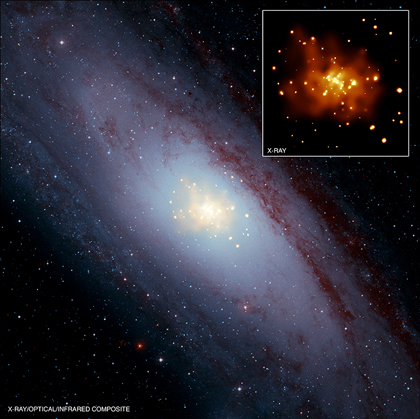NASA's Chandra Reveals Origin of Key Cosmic Explosions
This composite image of M31 (also known as the Andromeda galaxy) shows X-ray data from NASA's Chandra X-ray Observatory in gold, optical data from the Digitized Sky Survey in light blue and infrared data from the Spitzer Space Telescope in red. The Chandra data covers only the central region of M31 as shown in the inset box for the image.

New results show that the Chandra image would be about 40 times brighter than observed if Type Ia supernova in the bulge of this galaxy were triggered by material from a normal star falling onto a white dwarf star. This implies that the merger of two white dwarfs is the main trigger for Type Ia supernovas for the area observed by Chandra. Similar results for five elliptical galaxies were found.
These findings represent a major advance in understanding the origin of Type Ia supernovas, explosions that are used as cosmic mile markers to measure the accelerated expansion of the universe and study dark energy. Most scientists agree that a Type Ia supernova occurs when a white dwarf star -- a collapsed remnant of an elderly star -- exceeds its weight limit, becomes unstable and explodes. However, there is uncertainty about what pushes the white dwarf over the edge, either accretion onto the white dwarf or a merger between two white dwarfs.
More: http://www.chandra.harvard.edu/photo/2010/type1a/
-K. Arcand, CXC
Please note this is a moderated blog. No pornography, spam, profanity or discriminatory remarks are allowed. No personal attacks are allowed. Users should stay on topic to keep it relevant for the readers.
Read the privacy statement
